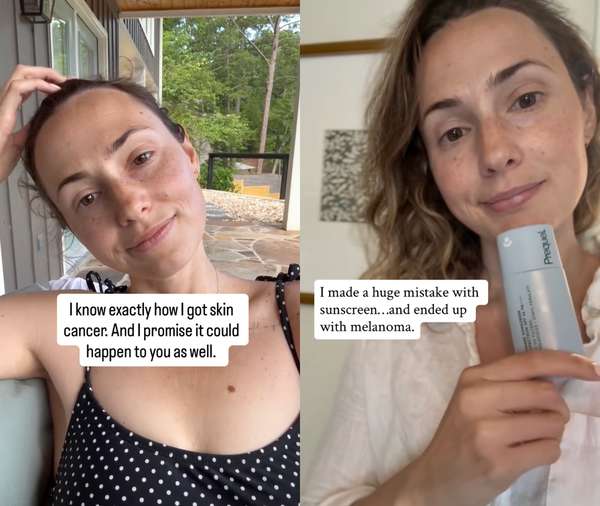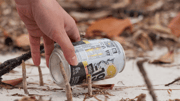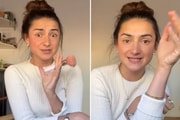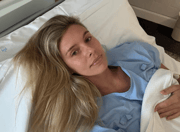
Gardening is one of life's great pleasures—the satisfaction of nurturing plants, the therapeutic benefits of working with soil, and the joy of watching your efforts bloom.
But for 37-year-old April Catudal from Atlanta, this beloved hobby delivered an unexpected and frightening wake-up call that every Australian gardener, especially those over 60, needs to hear.
What started as innocent hours spent planting and mulching turned into a Stage 1A melanoma diagnosis that has completely changed how she approaches time outdoors. Her story is particularly sobering for Australians, who face the highest melanoma rates in the world.
In this article
A routine check-up becomes a nightmare
In 2024, it is estimated that a person has a 1 in 17 (or 6.0 per cent) risk of being diagnosed with melanoma by the age of 85, and April never expected to become part of that statistic. She considered herself healthy and active—walking daily, working out regularly, and spending time in her garden.
'I walked for at least an hour outside every day, gardened, worked out every day,' she explained. 'I definitely would consider myself active.'
When she booked her annual skin exam in June, she expected nothing more than a routine check-up. After all, she'd been getting regular skin examinations for 10 years without so much as a biopsy. But this time, her dermatologist noticed something different—a mole on her neck that warranted closer investigation.
The biopsy results were shocking: Stage 1A melanoma.
'I stupidly didn't think it was that important to wear a hat, even though my neck was exposed to the sun from squatting constantly'
Looking back, April believes her new gardening hobby may have contributed to her diagnosis. Between March and June, she'd spent hours each day planting and laying mulch—often in a T-shirt without adequate sun protection.
'I wore sunscreen intermittently but thought it was mostly fine as long as it wasn't peak sun or I wasn't burning,' she admitted.
Why Australians face the world's highest risk
April's story should serve as a particular warning for Australian gardeners. Australia has the highest melanoma rates in the world. Melanoma is often referred to as 'Australia's national cancer', with sobering statistics that put the urgency of sun protection into stark perspective.
In 2024, it is estimated that 18,964 new cases of melanoma will be diagnosed in Australia (11,034 males and 7,930 females), representing a significant increase from recent years. But it's the age-specific statistics that should particularly concern Australian seniors.
Australian melanoma statistics that will shock you
1 in 17 Australians will be diagnosed with melanoma by age 85
One Australian is diagnosed with melanoma every 30 minutes
The incidence rate is expected to increase with age, highest for those aged 85-89 years
At least 2 in 3 Australians will be diagnosed with skin cancer in their lifetime
The continuation of increasing melanoma incidence risk is driven by risks from the older population
The research reveals a troubling pattern: impacts of an ageing population will continue to place upwards pressure on the risk of being diagnosed with melanoma, particularly for ageing populations living in times when 'Sunsmart' awareness was less.
This means that Australians over 60 today grew up during an era when sun protection wasn't emphasised, potentially accumulating decades of UV damage before sun-smart campaigns began in the 1980s.
The hidden danger in everyday activities
One of the most concerning aspects of April's story is how 'ordinary' her sun exposure seemed. She wasn't lounging on beaches or seeking a tan—she was simply tending to her garden, an activity millions of Australians enjoy daily.
When you're out doing daily activities, such as walking the dog, gardening or hanging out the washing, you can get caught off guard by UV radiation you're not aware of, warns Cancer Council Australia.
Over-exposure to UV radiation causes up to 95 per cent of melanomas, making these seemingly innocent moments potentially dangerous.
The problem with gardening is the prolonged, repeated exposure—often in positions that expose typically protected areas like the neck and shoulders. April's melanoma was located on her neck, exactly where she'd been most exposed while squatting to tend her plants.
Essential sun protection for Australian gardeners
- Choose a broad-brimmed, legionnaire or bucket style hat which shades your face, nose, neck and ears
- Use the highest possible SPF sunscreen (currently SPF50+ in Australia) with broad spectrum UVA and UVB protection
- Apply sunscreen to clean, dry skin at least 20 minutes before going outside—use a teaspoon for head and neck
- Choose clothing that covers as much skin as possible, such as collared shirts with long sleeves
- Check UV levels daily—sun protection is recommended whenever UV levels reach 3 or higher
- Reapply sunscreen at least every two hours, regardless of water resistance
The gardening generation at greatest risk
Research shows that the increase in incidence over time was statistically significant for people aged 65 years or more, while younger Australians who've grown up with sun-smart messaging show declining melanoma rates.
While populations over 40 have increasing incidence rates, the rate increases are greater for the oldest populations who are likely to have spent more of their lives in times when there was less skin cancer awareness. This creates a perfect storm for today's gardening enthusiasts over 60.
Many of this generation discovered gardening later in life, coinciding with retirement and more time to spend outdoors.
Unfortunately, this timing means they're engaging in a high-UV-exposure hobby at an age when their lifetime sun damage is already significant, and their skin is most vulnerable.
The encouraging survival statistics—if caught early
Despite the sobering statistics, there's reason for hope. Since 1996-2000, 5-year melanoma survival rates have been a little over 90 per cent. The melanoma 5-year survival rate for 2016-2020 was 94 per cent—but early detection is crucial.
April's experience reinforces this critical point. Her Stage 1A diagnosis, caught during a routine skin check, meant successful surgical removal and a declaration of being cancer-free. However, she's now 10 percent more likely to have other melanomas pop up, especially over the next two years, requiring ongoing vigilance.
'Early detection is everything with skin cancer. And could mean the difference between life and death,' April emphasised.
The financial aspect shouldn't be ignored either. April faced $1,300 in out-of-pocket costs for her biopsy and surgery. While Australia's healthcare system provides better coverage than the US, early detection still represents the most cost-effective approach for both individuals and the healthcare system.
Taking action: what Australian gardeners need to do now
Studies have shown regular sunscreen use, particularly during the formative years, can reduce melanoma risk by 40 per cent, but it's never too late to start protecting yourself. For Australian gardeners, especially those over 60, this means fundamentally changing how you approach your hobby.
The SunSmart approach, developed by Cancer Council Australia, provides a comprehensive framework: Slip on sun-protective clothing, Slop on sunscreen, Slap on a hat, Seek shade, and Slide on sunglasses.
For gardeners specifically, this means investing in proper protective gear: UPF-rated gardening clothes, wide-brimmed hats that protect the neck and ears, and making sunscreen application as routine as putting on gardening gloves.
Did you know?
Did you know?
The most comprehensive study of cancer prevention in Australia estimated that, in 2010, more than 1700 cases of melanoma and 14,190 squamous cell carcinomas were prevented by long-term sunscreen use. This shows that consistent protection really works.
Regular skin checks save lives
April's story also highlights the absolute importance of regular professional skin examinations. Check your skin regularly for any new spots or changes in shape, colour or size of existing spots.
If you notice anything unusual, see your doctor as soon as possible. Most skin cancer can be successfully treated if it is found early.
For Australians over 60, annual skin checks should be non-negotiable. Many don't realise that Medicare provides rebates for skin cancer screening and treatment, making regular monitoring more accessible than ever.
The stark reality is that Australia's gardening generation faces a unique challenge: a lifetime of accumulated sun damage combined with continued high-risk sun exposure through their favourite hobby. But with proper protection and regular monitoring, this risk can be significantly reduced.
What This Means For You
Don't let April's story become your story. If you're an Australian gardener, especially over 60, it's time to take action:
Immediate actions:
- Download the free SunSmart app to check daily UV levels
- Book an annual skin check if you haven't had one
- Invest in proper sun-protective gardening gear
- Make SPF50+ broad-spectrum sunscreen part of your daily routine
For more information:
- Cancer Council Australia: 13 11 20
- Melanoma Institute Australia: melanoma.org.au
- SunSmart: sunsmart.com.au
April's final advice resonates particularly strongly for Australian gardeners: 'It sucks, but it's so, so preventable.' With Australia's extreme UV levels and world-leading melanoma rates, prevention isn't just recommended—it's essential for anyone who wants to keep enjoying their garden for years to come.
The choice is yours: continue gardening unprotected and risk joining Australia's alarming melanoma statistics, or take simple protective steps that can save your life. April's story proves that even 'safe' activities can be dangerous—but it also shows that early detection and proper protection can make all the difference.
What changes will you make to your gardening routine? Have you had a professional skin check recently? Your story might help save another gardener's life.
Original Article
https://www.dailymail.co.uk/femail/...tml?ns_mchannel=rss&ns_campaign=1490&ito=1490
Melanoma of the skin statistics | Cancer Australia
Cited text: In 2024, it is estimated that a person has a 1 in 17 (or 6.0 per cent) risk of being diagnosed with melanoma of the skin by the age of 85 (1 in 14 or 7.0 per cent for...
Excerpt: In 2024, it is estimated that a person has a 1 in 17 (or 6.0 per cent) risk of being diagnosed with melanoma by the age of 85
https://www.canceraustralia.gov.au/cancer-types/melanoma-skin/melanoma-skin-statistics
Melanoma Facts—Melanoma Institute Australia
Cited text: Australia has the highest melanoma rates in the world. Melanoma is often referred to as ‘Australia’s national cancer’.
Excerpt: Australia has the highest melanoma rates in the world. Melanoma is often referred to as 'Australia's national cancer'
https://melanoma.org.au/about-melanoma/melanoma-facts/
Melanoma of the skin statistics | Cancer Australia
Cited text: In 2024, it is estimated that 18,964 new cases of melanoma of the skin will be diagnosed in Australia (11,034 males and 7,930 females).
Excerpt: In 2024, it is estimated that 18,964 new cases of melanoma will be diagnosed in Australia (11,034 males and 7,930 females)
https://www.canceraustralia.gov.au/cancer-types/melanoma-skin/melanoma-skin-statistics
Melanoma Facts—Melanoma Institute Australia
Cited text: It is expected that 16,800 Australians will be diagnosed with melanoma this year · 1 Australian is diagnosed with melanoma every 30 minutes · It is es...
Excerpt: One Australian is diagnosed with melanoma every 30 minutes
https://melanoma.org.au/about-melanoma/melanoma-facts/
Melanoma of the skin statistics | Cancer Australia
Cited text: The incidence rate for melanoma of the skin is expected to increase with age, highest for those aged 85—89 years.
Excerpt: The incidence rate is expected to increase with age, highest for those aged 85—89 years
https://www.canceraustralia.gov.au/cancer-types/melanoma-skin/melanoma-skin-statistics
Incidence and mortality | National Cancer Prevention Policy Skin Cancer Statistics and Issues | Cancer Council
Cited text: At least 2 in 3 Australians will be diagnosed with skin cancer in their lifetime,[4] and the risk is higher in men than in women.
Excerpt: At least 2 in 3 Australians will be diagnosed with skin cancer in their lifetime
https://www.cancer.org.au/about-us/...resources/skin-cancer-incidence-and-mortality
Cancer data in Australia, Risk of melanoma of the skin by age and over time—Australian Institute of Health and Welfare
Cited text: Considering the younger population’s melanoma of the skin incidence risk has been decreasing and incidence risk by the age of 60 has been stabilising,...
Excerpt: The continuation of increasing melanoma incidence risk is driven by risks from the older population
https://www.aihw.gov.au/reports/can...nts/cancer-data-commentaries/risk-of-melanoma
Cancer data in Australia, Risk of melanoma of the skin by age and over time—Australian Institute of Health and Welfare
Cited text: While melanoma mortality risk peaked in 2013, impacts of an ageing population (that is, more people living to ages where melanoma incidence rates are ...
Excerpt: impacts of an ageing population will continue to place upwards pressure on the risk of being diagnosed with melanoma, particularly for ageing populations living in times when 'Sunsmart' awareness was less
https://www.aihw.gov.au/reports/can...nts/cancer-data-commentaries/risk-of-melanoma
National Skin Cancer Action Week | Combatting Australia’s ‘national cancer’ | Cancer Council
Cited text: When you’re out doing daily activities, such as walking the dog, gardening or hanging out the washing, you can get caught off guard by UV radiation yo...
Excerpt: When you're out doing daily activities, such as walking the dog, gardening or hanging out the washing, you can get caught off guard by UV radiation you're not aware of
https://www.cancer.org.au/cancer-in...s-and-events/national-skin-cancer-action-week
National Skin Cancer Action Week | Combatting Australia’s ‘national cancer’ | Cancer Council
Cited text: In fact, over-exposure to UV radiation causes up to 95 per cent of melanomas.
Excerpt: Over-exposure to UV radiation causes up to 95 per cent of melanomas
https://www.cancer.org.au/cancer-in...s-and-events/national-skin-cancer-action-week
Be SunSmart | Cancer Council
Cited text: Choose, a broad-brimmed, legionnaire or bucket style hat which shades your face, nose, neck and ears, which are common sites for skin cancers.
Excerpt: Choose a broad-brimmed, legionnaire or bucket style hat which shades your face, nose, neck and ears
https://www.cancer.org.au/cancer-information/causes-and-prevention/sun-safety/be-sunsmart
Sunscreen FAQs—Melanoma Institute Australia
Cited text: We advise using the highest possible SPF sunscreen (currently SPF50+ in Australia) with broad spectrum UVA and UVB protection.
Excerpt: Use the highest possible SPF sunscreen (currently SPF50+ in Australia) with broad spectrum UVA and UVB protection
https://melanoma.org.au/about-melanoma/how-to-prevent-melanoma/sunscreen-faqs/
Be SunSmart | Cancer Council
Cited text: Apply a generous amount of sunscreen to clean, dry skin at least 20 minutes before you go outside. The average-sized adult will need a teaspoon of sun...
Excerpt: Apply sunscreen to clean, dry skin at least 20 minutes before going outside—use a teaspoon for head and neck
https://www.cancer.org.au/cancer-information/causes-and-prevention/sun-safety/be-sunsmart
Be SunSmart | Cancer Council
Cited text: Choose clothing that covers as much skin as possible, for example, collared shirts with long sleeves.
Excerpt: Choose clothing that covers as much skin as possible, such as collared shirts with long sleeves
https://www.cancer.org.au/cancer-information/causes-and-prevention/sun-safety/be-sunsmart
Be SunSmart | Cancer Council
Cited text: Sun protection is recommended whenever UV levels reach 3 or higher.
Excerpt: Check UV levels daily—sun protection is recommended whenever UV levels reach 3 or higher
https://www.cancer.org.au/cancer-information/causes-and-prevention/sun-safety/be-sunsmart
Preventing skin cancer | Cancer Council
Cited text: When spending time outdoors, sunscreen should always be reapplied at least every two hours, irrespective of the water resistance of the sunscreen.
Excerpt: Reapply sunscreen at least every two hours, regardless of water resistance
https://www.cancer.org.au/cancer-information/causes-and-prevention/sun-safety/preventing-skin-cancer
Changes in the incidence of melanoma in Australia, 2006—2021, by age group and ancestry: a modelling study | The Medical Journal of Australia
Cited text: In the high ancestral risk group, the increase in incidence over time was, in general, statistically significant for people aged 65 years or more, whe...
Excerpt: the increase in incidence over time was statistically significant for people aged 65 years or more
https://www.mja.com.au/journal/2024...ia-2006-2021-age-group-and-ancestry-modelling
Cancer data in Australia, Overview of cancer in Australia, 2024—Australian Institute of Health and Welfare
Cited text: While populations over 40 have increasing incidence rates, the rate increases are greater for the oldest populations who are likely to have spent more...
Excerpt: While populations over 40 have increasing incidence rates, the rate increases are greater for the oldest populations who are likely to have spent more of their lives in times when there was less skin cancer awareness
https://www.aihw.gov.au/reports/cancer/cancer-data-in-australia/contents/overview
Cancer data in Australia, Overview of cancer in Australia, 2024—Australian Institute of Health and Welfare
Cited text: Since 1996—2000, 5-year melanoma of the skin survival rates have been a little over 90 per cent. The melanoma of the skin 5-year survival rate for 2016—2020 w...
Excerpt: Since 1996—2000, 5-year melanoma survival rates have been a little over 90 per cent. The melanoma 5-year survival rate for 2016—2020 was 94 per cent
https://www.aihw.gov.au/reports/cancer/cancer-data-in-australia/contents/overview
Melanoma of the skin statistics | Cancer Australia
Cited text: Age-standardised mortality ... More information about mortality rates for melanoma of the skin over time, by age, sex, Indigenous status, remoteness, ...
Excerpt: 10 percent more likely to have other melanomas pop up, especially over the next two years
https://www.canceraustralia.gov.au/cancer-types/melanoma-skin/melanoma-skin-statistics
Melanoma of the skin statistics | Cancer Australia
Cited text:
Excerpt: 10 percent more likely to have other melanomas pop up, especially over the next two years
https://www.canceraustralia.gov.au/cancer-types/melanoma-skin/melanoma-skin-statistics
Sunscreen FAQs—Melanoma Institute Australia
Cited text: Studies have shown regular sunscreen use, particularly during the formative years, can reduce melanoma risk by 40 per cent (2018 study from The University of ...
Excerpt: Studies have shown regular sunscreen use, particularly during the formative years, can reduce melanoma risk by 40 per cent
https://melanoma.org.au/about-melanoma/how-to-prevent-melanoma/sunscreen-faqs/
About sunscreen | Cancer Council
Cited text: The most comprehensive study of cancer prevention in Australia estimated that, in 2010, more than 1700 cases of melanoma and 14,190 squamous cell carc...
Excerpt: The most comprehensive study of cancer prevention in Australia estimated that, in 2010, more than 1700 cases of melanoma and 14,190 squamous cell carcinomas were prevented by long-term sunscreen use
https://www.cancer.org.au/cancer-information/causes-and-prevention/sun-safety/about-sunscreen
Be SunSmart | Cancer Council
Cited text: Check your skin regularly for any new spots or changes in shape, colour or size of existing spots. If you notice anything unusual, see your doctor as ...
Excerpt: Check your skin regularly for any new spots or changes in shape, colour or size of existing spots.
https://www.cancer.org.au/cancer-information/causes-and-prevention/sun-safety/be-sunsmart







